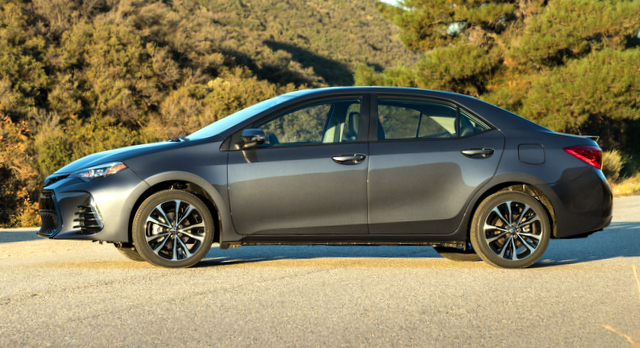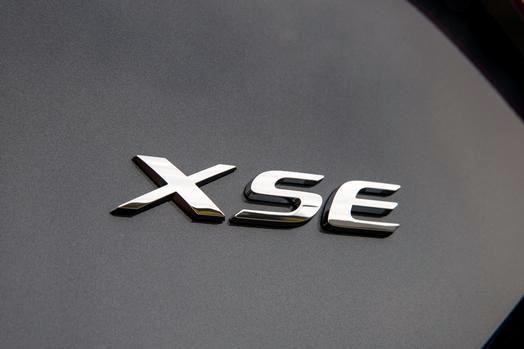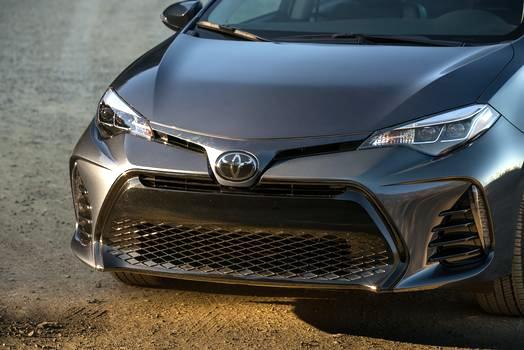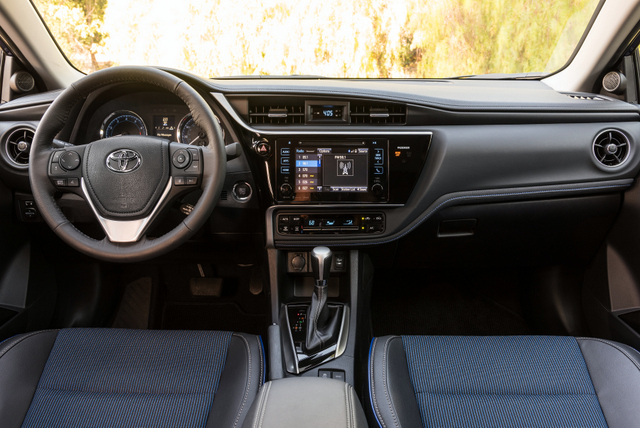More than Half a Century of Success
The Toyota Corolla is the most popular car ever made. Now in its 52nd year and 11th generation, it has sold over 44 million units worldwide during its long lifespan, and Toyota adds about 1.5 million to that total every year. The cars are sold in more than 150 countries and built in 16 plants, including two in North America—one in Blue Springs, Mississippi, and Cambridge, Ontario, Canada, where my 2018 Toyota Corolla test car was made.

It’s easy to spot models from nearly all generations of Corolla on the road today. That’s because Toyota sold so many, and because they built them to last.
While cars like the Honda Civic reinvent themselves every generation, the Corolla has grown and matured through the decades while retaining its reasonable, easy-to-ignore simplicity. Sometimes boxy, sometimes rounded, the general practicality and accessibility remain. Today’s Corolla comes only as a four-door sedan, but there have been wagon and hatchback models over the years.
A Look Back
The first Corollas were released in Japan in late 1966. Some made it to the U.S. The second generation was a little more appealing. My brother had a yellow 1973 model that we drove together from Alabama to Arizona during one hot summer. The slightly larger, sharper-edged third-generation car was sold for the rest of the 1970s. My other brother drove a silver one.
The Corolla has grown tremendously since it arrived. For example, the wheelbase of the 1966 car was just 90 inches. By 1987 it stretched to 95.7 inches. Today’s car extends to 106.3 inches. The 2018 car is more than 30 inches longer and 11 inches wider than the 1966 version. Naturally, engine size and standard equipment have increased, too.

To keep it accessible to a wide group of shoppers, the Corolla comes in six grades, from the base L through the popular LE model, and XLE, SE, and top XSE. There is also an Eco version of the LE, which through some tweaks and adjustments (and nearly 300 pounds less mass than the XSE), pushes the fuel economy numbers up a few clicks, hitting the magic 40 miles per gallon highway.
Testing the Top-of-the-Line
My test car, in a jaunty Blue Crush Metallic, was an XSE, so it had pretty much everything. The Entune upgraded audio system ($525) was welcome. However, the TRD (Toyota Racing Development) branded performance exhaust gave the car a throaty roar when accelerating that wasn’t music to my ears. The TRD items, including air filter and sway bar, added more than $1,000 to the car.
The engine is a 1.8-liter inline four-cylinder unit driving the front wheels through a continuously-variable automatic transmission (CVT). It’s good for an adequate 132 horsepower and 128 pounds-feet of torque, moving 2,870 pounds of car. The CVT features Intelligence Shift, which provides a more natural feel, replicating a traditional six-speed automatic.

The official EPA numbers were 28 city/35 highway/31 combined. However, I only got 26 mpg during my test. The Green scores are a disappointing 3 for Smog, but a better 7 for Greenhouse gas, so the car earns EPA Smartway status.
The current Corolla is squinty with a big mouth, like its popular brand mate, the RAV4 crossover. Based on the looks of the 2018 Camry, I expect the next-gen Corolla will get more expressive details.
Driving the Corolla
Driving the Corolla, you feel safe, secure. Everything is well-made and works great, but there is little luxury or excitement. My car’s black interior was a letdown after the promise of fun from the bright blue body.
The base car starts at a mere $19,495, although there are few takers, I suspect. Most are willing to move up to the LE for just $435 more, which adds nicer seat fabric, remote keyless entry, auto climate control, and power mirrors.

As a top-level car, my XSE wore Softex artificial leather on heated seats. It also provided premium instrumentation, smart key entry and a leather-wrapped steering wheel with redundant controls. It came with a tilt/slide moonroof, 17-inch alloy wheels and front and rear disc brakes.
Every Corolla comes with standard Scout navigation, an illuminated visor vanity mirror and, perhaps more importantly, Toyota Safety Sense. This collection of high-tech lifesaving and accident avoiding devices includes pre-collision and pedestrian detection, lane departure alert and steering assist, dynamic radar cruise control and auto high beams.
My test car carried a base price of $22,730 and, with options and delivery, came to $25,337. By today’s standards, that’s an impressive bargain, although it’s a lot for a Corolla.
If you want a compact car you can buy without worry that will give you years of reliable service but few thrills, the 2018 Toyota Corolla remains a very viable choice.
Related Stories You Might Enjoy—Other Compact Choices
Road Test: 2018 Chevrolet Cruze Diesel
Road Test: 2017 Chevrolet Cruze
Road Test: 2016 Ford Focuc Electric
Flash Drive: 2016 Nissan Sentra
Road Test: 2016 Honda Civic
Disclosure:
Clean Fleet Report is loaned free test vehicles from automakers to evaluate, typically for a week at a time. Our road tests are based on this one-week drive of a new vehicle. Because of this we don’t address issues such as long-term reliability or total cost of ownership. In addition, we are often invited to manufacturer events highlighting new vehicles or technology. As part of these events we may be offered free transportation, lodging or meals. We do our best to present our unvarnished evaluations of vehicles and news irrespective of these inducements.
Our focus is on vehicles that offer the best fuel economy in their class, which leads us to emphasize electric cars, plug-in hybrids, hybrids and diesels. We also feature those efficient gas-powered vehicles that are among the top mpg vehicles in their class. In addition, we aim to offer reviews and news on advanced technology and the alternative fuel vehicle market. We welcome any feedback from vehicle owners and are dedicated to providing a forum for alternative viewpoints. Please let us know your views at publisher@cleanfleetreport.com.
